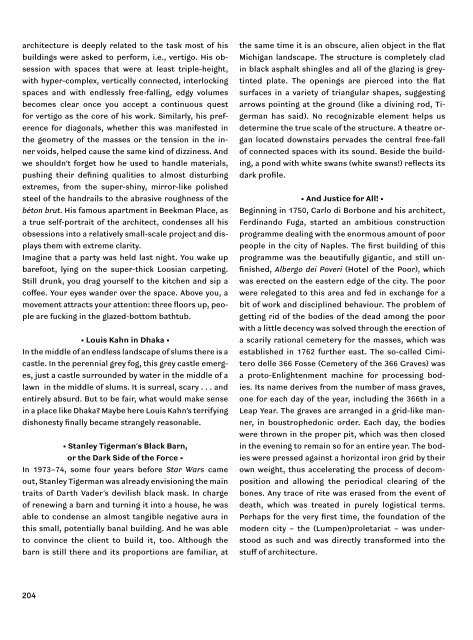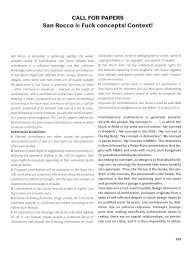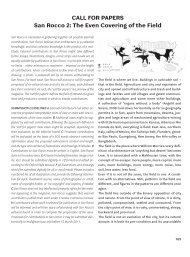CALL FOR PAPERS San Rocco 5: Scary Architects
CALL FOR PAPERS San Rocco 5: Scary Architects
CALL FOR PAPERS San Rocco 5: Scary Architects
Create successful ePaper yourself
Turn your PDF publications into a flip-book with our unique Google optimized e-Paper software.
architecture is deeply related to the task most of his<br />
buildings were asked to perform, i.e., vertigo. His obsession<br />
with spaces that were at least triple-height,<br />
with hyper-complex, vertically connected, interlocking<br />
spaces and with endlessly free-falling, edgy volumes<br />
becomes clear once you accept a continuous quest<br />
for vertigo as the core of his work. Similarly, his preference<br />
for diagonals, whether this was manifested in<br />
the geometry of the masses or the tension in the inner<br />
voids, helped cause the same kind of dizziness. And<br />
we shouldn’t forget how he used to handle materials,<br />
pushing their defining qualities to almost disturbing<br />
extremes, from the super-shiny, mirror-like polished<br />
steel of the handrails to the abrasive roughness of the<br />
béton brut. His famous apartment in Beekman Place, as<br />
a true self-portrait of the architect, condenses all his<br />
obsessions into a relatively small-scale project and displays<br />
them with extreme clarity.<br />
Imagine that a party was held last night. You wake up<br />
barefoot, lying on the super-thick Loosian carpeting.<br />
Still drunk, you drag yourself to the kitchen and sip a<br />
coffee. Your eyes wander over the space. Above you, a<br />
movement attracts your attention: three floors up, people<br />
are fucking in the glazed-bottom bathtub.<br />
• Louis Kahn in Dhaka •<br />
In the middle of an endless landscape of slums there is a<br />
castle. In the perennial grey fog, this grey castle emerges,<br />
just a castle surrounded by water in the middle of a<br />
lawn in the middle of slums. It is surreal, scary . . . and<br />
entirely absurd. But to be fair, what would make sense<br />
in a place like Dhaka? Maybe here Louis Kahn’s terrifying<br />
dishonesty finally became strangely reasonable.<br />
• Stanley Tigerman’s Black Barn,<br />
or the Dark Side of the Force •<br />
In 1973–74, some four years before Star Wars came<br />
out, Stanley Tigerman was already envisioning the main<br />
traits of Darth Vader’s devilish black mask. In charge<br />
of renewing a barn and turning it into a house, he was<br />
able to condense an almost tangible negative aura in<br />
this small, potentially banal building. And he was able<br />
to convince the client to build it, too. Although the<br />
barn is still there and its proportions are familiar, at<br />
204<br />
the same time it is an obscure, alien object in the flat<br />
Michigan landscape. The structure is completely clad<br />
in black asphalt shingles and all of the glazing is greytinted<br />
plate. The openings are pierced into the flat<br />
surfaces in a variety of triangular shapes, suggesting<br />
arrows pointing at the ground (like a divining rod, Tigerman<br />
has said). No recognizable element helps us<br />
determine the true scale of the structure. A theatre organ<br />
located downstairs pervades the central free-fall<br />
of connected spaces with its sound. Beside the building,<br />
a pond with white swans (white swans!) reflects its<br />
dark profile.<br />
• And Justice for All! •<br />
Beginning in 1750, Carlo di Borbone and his architect,<br />
Ferdinando Fuga, started an ambitious construction<br />
programme dealing with the enormous amount of poor<br />
people in the city of Naples. The first building of this<br />
programme was the beautifully gigantic, and still unfinished,<br />
Albergo dei Poveri (Hotel of the Poor), which<br />
was erected on the eastern edge of the city. The poor<br />
were relegated to this area and fed in exchange for a<br />
bit of work and disciplined behaviour. The problem of<br />
getting rid of the bodies of the dead among the poor<br />
with a little decency was solved through the erection of<br />
a scarily rational cemetery for the masses, which was<br />
established in 1762 further east. The so-called Cimi-<br />
tero delle 366 Fosse (Cemetery of the 366 Graves) was<br />
a proto-Enlightenment machine for processing bodies.<br />
Its name derives from the number of mass graves,<br />
one for each day of the year, including the 366th in a<br />
Leap Year. The graves are arranged in a grid-like manner,<br />
in boustrophedonic order. Each day, the bodies<br />
were thrown in the proper pit, which was then closed<br />
in the evening to remain so for an entire year. The bodies<br />
were pressed against a horizontal iron grid by their<br />
own weight, thus accelerating the process of decomposition<br />
and allowing the periodical clearing of the<br />
bones. Any trace of rite was erased from the event of<br />
death, which was treated in purely logistical terms.<br />
Perhaps for the very first time, the foundation of the<br />
modern city – the (Lumpen)proletariat – was understood<br />
as such and was directly transformed into the<br />
stuff of architecture.




